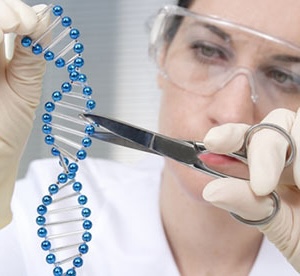
CRISPR-based drugs: one giant leap for mankind
Casgevy is the first CRISPR-based drug to make its way through the approval process, all but curing Sickle Cell Disease and it’s paving the way for similar drugs targeting other diseases. Is Huntington’s disease next?

You’ve likely heard of CRISPR. By now, you also may have heard that CRISPR has been used to produce a revolutionary new treatment for Sickle Cell Disease. Just 4 years after the Nobel Prize for the discovery of CRISPR was awarded, we have an approved treatment using this technology. This may have you wondering if this approach is being used in Huntington’s disease (HD) research and when a similar drug for HD might come to the clinic. Let’s discuss!
Genetic scissors transform science
CRISPR is short for “clustered regularly interspaced short palindromic repeats” – quite a mouthful! That’s essentially just science-speak for short strings of DNA letters that break up repeating parts of genetic code. These so-called CRISPR sequence interruptions were first noticed in bacteria. The unique strings of DNA letters which make up these sequences appear to have come from viruses, which scientists think might be part of an immune system that protects bacteria against viruses that they previously encountered.

The real secret sauce that transformed CRISPR into a powerful tool with the potential to treat many diseases are proteins called Cas – “CRISPR-associated sequence” proteins. If the CRISPR system as a whole is thought of as “genetic scissors”, the Cas proteins are the scissors themselves – they are the enzyme that actually cuts the DNA. The CRISPR sequences are the guide that show where the DNA should be cut. For this discovery in 2012, Drs. Emmanuelle Charpentier and Jennifer Doudna won the Nobel Prize in Chemistry in 2020 for the use of the CRISPR/Cas system to precisely edit DNA. An all-female Nobel team!
The CRISPR system wasn’t the first tool that allowed researchers to cut DNA, but it took off like wildfire throughout research labs around the world because it was easier, cheaper, and more accurate. Having an easy to use system to precisely edit DNA has revolutionized how researchers work in the lab. It can not only be used to turn genes on or off, but can also edit their DNA letter code. This holds a lot of promise for genetic diseases like HD where changes to the DNA letter code are the root cause of the disease.
Targeting Sickle Cell Disease with CRISPR
Once scientists knew how easy it was to edit DNA with the CRISPR system, lots of different companies began working with the technology to target various diseases. So why did the first approved CRISPR-based treatment focus on Sickle Cell and what exactly is it? Let’s focus on what Sickle Cell Disease is first.
Sickle Cell Disease is a blood disorder that gives red blood cells a sickle shape, like the letter “C”. Genetically, this is caused by mutation of a gene called hemoglobin that allows red blood cells to hold oxygen. If red blood cells aren’t carrying oxygen to parts of the body where it’s needed, this can lead to a stroke. The sickle-shaped red blood cells get all clumped together, leading to clogged blood vessels. With fewer red blood cells, people with Sickle Cell Disease are anemic, experience swelling of the hands and feet, and extreme fatigue. Sickle Cell Disease is recessively inherited. This means that both parents must have a faulty copy of the gene to pass the disease on to their kids, who have a 25% chance of inheriting the condition.
Drug discovery companies looking for a way to use CRISPR in the clinic focused on Sickle Cell Disease for several reasons:
-
1) The genetic cause is known. Sickle Cell Disease was first described all the way back in 1870. Hemoglobin as the cause was first noted in 1927 and the genetic basis was first described in 1949. So it has a long history!
-
2) The cure is already known! Increasing levels of hemoglobin essentially erases symptoms of the disease. So companies already knew what they had to do to treat the disease.
-
3) It affects red blood cells, which only live for about 120 days and new ones are constantly being made by the body. Additionally, red blood cells are made in bone marrow. Bone marrow transplants have a long medical history and have been well studied.
-
4) Genetic editing can be done outside the body. Because bone marrow transplants have been successful for other applications, researchers planned to take bone marrow stem cells out, treat them with CRISPR technology, and then put them back again. This is a lower risk approach than treating cells still inside the body because they could start over if something went wrong with the CRISPR editing process, and no one would be harmed.
How the drug works
“Any disease with a known genetic cause is a candidate for a CRISPR approach. This includes HD.”
With a disease in their targets, CRISPR Therapeutics and Vertex Pharmaceuticals tested their first CRISPR-based treatment for Sickle Cell Disease in a person in 2019. The drug, Casgevy, received approval in the United Kingdom and United States in November and December of 2023, respectively.
Once a patient is identified, bone marrow stem cells are removed. They are taken back to a lab where they are edited using CRISPR therapy. This editing modifies the faulty hemoglobin gene that prevents red blood cells from holding their shape and carrying oxygen. After editing, the cells have to be “grown” in the lab – essentially scientists feed them nutrients and watch over them closely to take care of them while they multiply, allowing the few cells they edited to divide into many cells.
With Casgevy-treated cells in hand, the cells are then returned back to the patient using an infusion. Now the Casgevy-treated cells can attach and turn from stem cells to red blood cells, producing new cells that have the corrected version of hemoglobin.
The good, the bad, and the ugly
As with all drugs, there will be pros and cons. The pro here (and it’s a big one) is that this is the first ever lifetime or one-shot treatment for Sickle Cell Disease! Casgevy is essentially a cure for Sickle Cell Disease which is a fantastic achievement for this community. However, even when a drug is the first or best in class, there can still be large drawbacks. In this case, Casgevy is complex to manufacture, will have a slow roll-out, and is very expensive.
Editing and growing the bone marrow stem cells has to happen in a specific facility with very strict manufacturing rules in place. These rules also require scientists with very specific training and skill sets. This reduces how fast the treatment can be produced and increases costs associated with the drug. The overall treatment takes about 6 months.
Prior to the infusion of the Casgevy-treated cells, the patient has to undergo high-dose chemotherapy in preparation of receiving the treatment. This can cause lots of side effects, like exhaustion, hair loss, and nausea. Chemotherapy is needed to remove blood stem cells that are left in the bone marrow. With the old blood cells gone, only the Casgevy-treated cells will be able to produce new red blood cells.
There are limitations on how fast this type of treatment can be rolled out. For instance, in the United States, there are currently about 25,000 bone marrow transplantations performed every year, but there are 100,000 people living with Sickle Cell Disease in the US. The current transplantations will still need to take place along with the new Casgevy treatments. So there is an issue with scaling up this treatment and finding the capacity to add to the current system.
Lastly, and perhaps most importantly for many people, Casgevy is very expensive. With the intense hands-on processing that Casgevy requires, it has a hefty price tag – $2.2 million according to Vertex. High price tags are likely to be the norm for one-shot drugs.
With all that in mind, Casgevy is still a massive leap forward for the Sickle Cell community and science as a whole. The first patient to be treated in the 2019 clinical trial was going to the hospital every 4 to 6 weeks for blood transfusions and her kids started struggling in school because they were worried about her dying if she didn’t receive treatment. After treatment with Casgevy, she no longer needs blood transfusions and her blood counts are stabilized; she’s essentially cured.

Where do CRISPR-based drugs stand for HD?
Sickle Cell and other blood disorders aren’t the only diseases that pharmaceutical companies are eyeing for CRISPR-based treatments. Any disease with a known genetic cause is a candidate for a CRISPR approach. This includes HD.
There is lots of work currently being done in cells and animal models to test CRISPR therapies that target various aspects of HD. Some researchers are directly going after the HTT gene that causes HD, while others are going after modifier genes that control age of onset. Having a diversity in approaches is a great thing!
There are also pharmaceutical companies that have committed to using a CRISPR-based approach for treating HD. Life Edit Therapeutics is a company that is working to use harmless viruses to deliver CRISPR machinery that will target only the expanded copy of HTT to lower expression. So far, they’ve tested this in different kinds of mice that model HD and have looked at different drug doses. While many people are currently working on CRISPR-based treatments for HD, none of these are currently in clinical trials.
Why aren’t CRISPR trials for HD in the clinic right now?
Having commercial approval for a CRISPR-based drug paves the way for similar drugs for other diseases, like HD. However, treating a blood disease is very different from treating a disease that primarily affects the brain. There are many aspects of Sickle Cell Disease that made it the perfect candidate for the first ever CRISPR-based drug. The other side of the coin is that there are many aspects of HD that make it a challenging disease to treat with CRISPR.
A major difference is that Sickle Cell Disease affects red blood cells while HD primarily affects brain cells. Blood cells are easy to access and blood sampling can be used to let doctors know if editing was successful. Brain cells can’t be sampled to get a picture of how the treatment is going.
Sickle Cell affects bone marrow that’s comparatively easy to manipulate and there’s lots of precedent for successful bone marrow transplantations. HD affects the brain, which requires invasive procedures to access and we don’t have a similar precedent for successful treatment of the brain.
Sickle Cell is caused by the lack of a protein, which many studies have shown can be added back to erase symptoms. We don’t yet know what will erase symptoms of HD. Researchers also have to weigh targeting both copies of HTT or only the expanded copy.
While this is a massive leap forward for using CRISPR to treat disease, we also want to manage expectations about when CRISPR-based treatments will be available for HD. Companies went for the low hanging fruit first with Sickle Cell Disease. However, none of this is to say that CRISPR won’t work for HD! On paper, this is a great strategy, HD fits the genetic requirement for such a treatment, and scientists love a good challenge. CRISPR-based treatments for brain diseases are certainly heading toward the clinic, but we have various other hurdles to clear first before they can be applied to HD.
Learn more
Sources & References
For more information about our disclosure policy see our FAQ…


